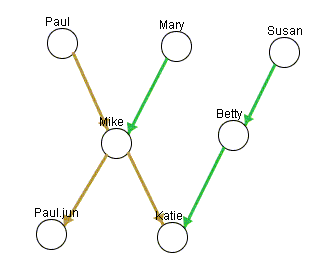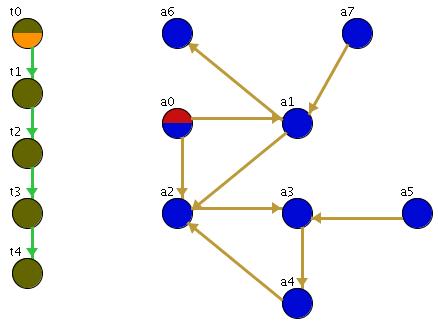More about Primula
The Primula system is a tool for probabilistic modelling of
relational structures. It is a Java-implementation of the language
of Relational Bayesian Networks . This language is designed for
the specification of general, adaptable probabilistic models. In a
specific application situation, this general model is instantiated to a
concrete probability distribution that can be encoded by a Bayesian
Network.
Here are two examples for Relational Modeling in Primula:
A Mendelian model of inheritance
The language of relational Bayesian networks can be used to encode
general models of inheritance. The relational Bayesian network
in mendel.rbn specifies a simple model for
the inheritance of a gene with two alleles.
This general model can be instantiated with arbitrary pedigrees. Applied to
the specific pedigree

the model defines a probability distribution over the genotypes of the individuals
in the pedigree. This distribution can be represented by a Bayesian network:

(all Bayesian networks shown on this page were drawn with
SamIam).
An Agent Communication Model
This is a toy model for communication in a network of agents.
The domain consists of a number of agents, some of whom are pairwise
connected by links. Some of the agents are of type source: these
agents receive at an initial time point t=0 a message. The relational
Bayesian network
distributed.rbn specifies a probabilistic model
for the propagation of the message over time. The general model can be
instantiated with arbitrary networks of agents, and arbitrary (finite) time
horizons.
Here is a domain of eight agents, and a five-step time structure (the specification
of input domain is supported by Primula's graphical domain editor).
 The probabilistic model defined for this particular domain can again be
represented by a Bayesian network. Here is a part of it:
The probabilistic model defined for this particular domain can again be
represented by a Bayesian network. Here is a part of it:

More about ...
Primula home | More about Primula
| User Manual
| Download
Manfred Jaeger
Last
modified: Thu Jun 18, 2009





